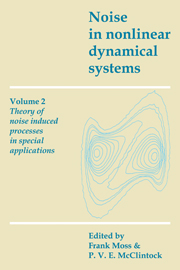Book contents
- Frontmatter
- Contents
- List of contributors
- Preface
- Introduction to Volume 2
- 1 Stochastic processes in quantum mechanical settings
- 2 Self-diffusion in non-Markovian condensed-matter systems
- 3 Escape from the underdamped potential well
- 4 Effect of noise on discrete dynamical systems with multiple attractors
- 5 Discrete dynamics perturbed by weak noise
- 6 Bifurcation behavior under modulated control parameters
- 7 Period doubling bifurcations: what good are they?
- 8 Noise-induced transitions
- 9 Mechanisms for noise-induced transitions in chemical systems
- 10 State selection dynamics in symmetry-breaking transitions
- 11 Noise in a ring-laser gyroscope
- 12 Control of noise by noise and applications to optical systems
- 13 Transition probabilities and spectral density of fluctuations of noise driven bistable systems
- Index
3 - Escape from the underdamped potential well
Published online by Cambridge University Press: 05 January 2012
- Frontmatter
- Contents
- List of contributors
- Preface
- Introduction to Volume 2
- 1 Stochastic processes in quantum mechanical settings
- 2 Self-diffusion in non-Markovian condensed-matter systems
- 3 Escape from the underdamped potential well
- 4 Effect of noise on discrete dynamical systems with multiple attractors
- 5 Discrete dynamics perturbed by weak noise
- 6 Bifurcation behavior under modulated control parameters
- 7 Period doubling bifurcations: what good are they?
- 8 Noise-induced transitions
- 9 Mechanisms for noise-induced transitions in chemical systems
- 10 State selection dynamics in symmetry-breaking transitions
- 11 Noise in a ring-laser gyroscope
- 12 Control of noise by noise and applications to optical systems
- 13 Transition probabilities and spectral density of fluctuations of noise driven bistable systems
- Index
Summary
Introduction
In this chapter we discuss a modest refinement of Kramers (1940) result for the noise activated escape out of an underdamped potential well. At very low damping, motion in a potential well (see Figure 3.1) is almost conservative, and the escape up in energy, out of the well, becomes difficult. This was appreciated by Kramers, who derived a result for extremely low damping. For a particle subject to thermal noise and damping proportional to the momentum p with a relaxation rate η, Kramers found an escape rate from the metastable state which is proportional to η. In the low friction limit it is diffusion up along the energy coordinate which limits the escape rate. On the other hand for large friction, the escape out of the potential well is limited by the diffusion along the reaction coordinate. For large friction the escape rate is proportional to η-1. Thus the escape rate as a function of the friction constant peaks at an intermediate value of the damping constant as shown in Figure 3.2. Kramers noted in his paper that it is the smaller of the two rates which applies. At very low damping, as the friction increases, the escape rate must eventually deviate from the linear behavior predicted by Kramers to merge at large η into the heavy damping behavior. It is this departure from the linear behavior for small damping which is the subject of this chapter.
Information
- Type
- Chapter
- Information
- Noise in Nonlinear Dynamical Systems , pp. 45 - 64Publisher: Cambridge University PressPrint publication year: 1989
Accessibility standard: Unknown
Why this information is here
This section outlines the accessibility features of this content - including support for screen readers, full keyboard navigation and high-contrast display options. This may not be relevant for you.Accessibility Information
- 3
- Cited by
